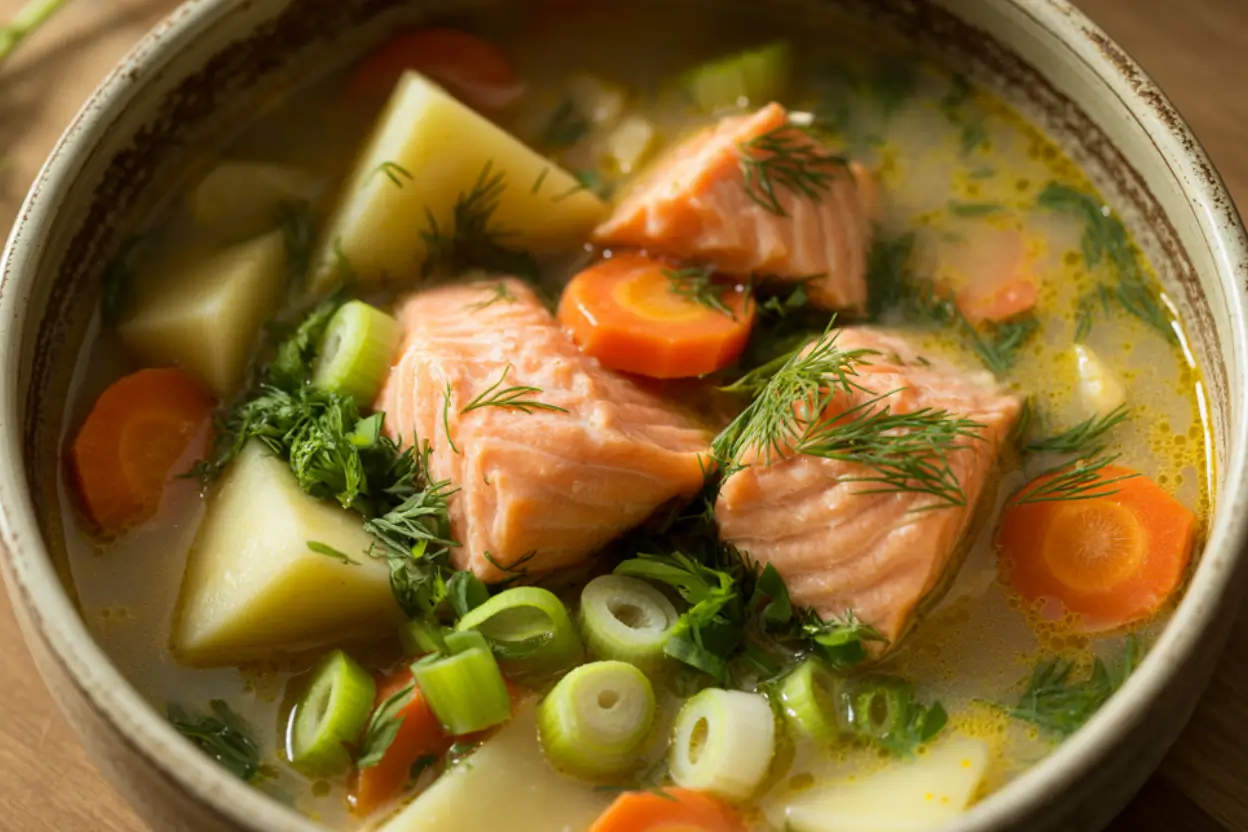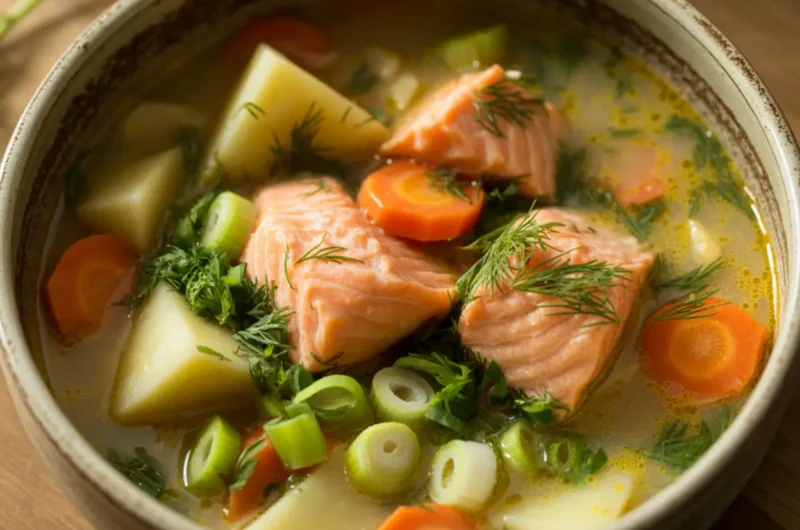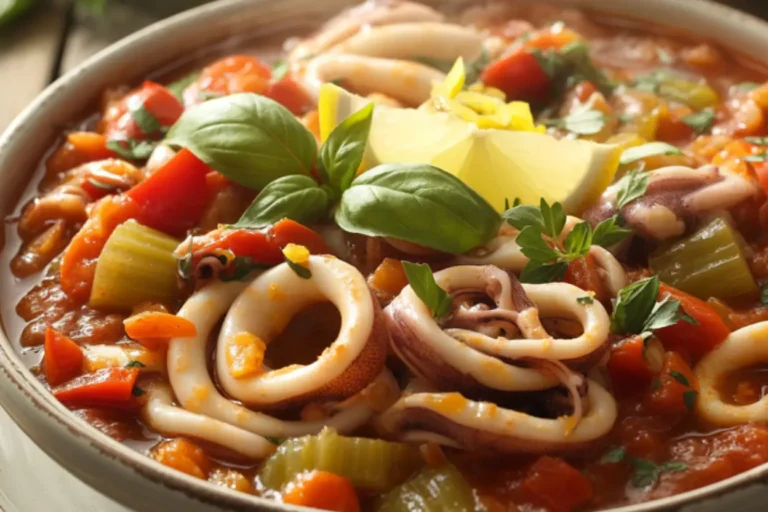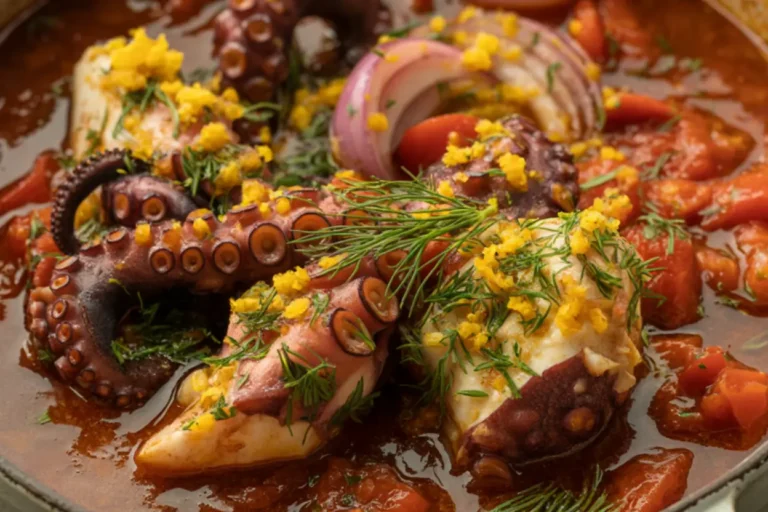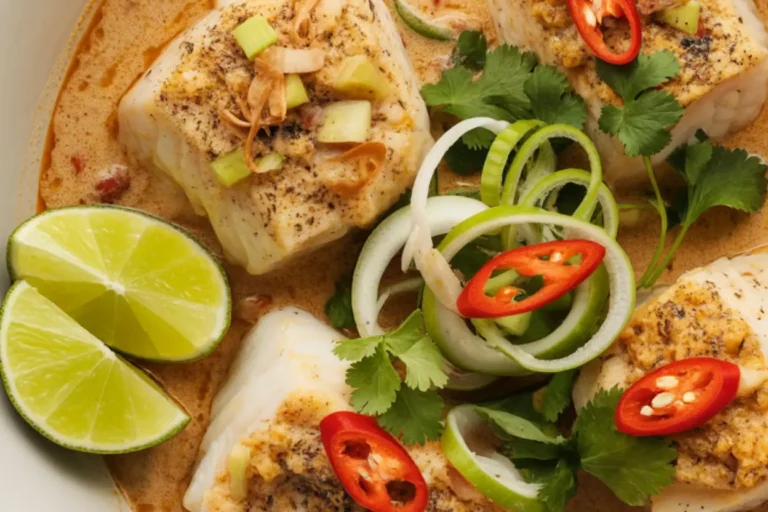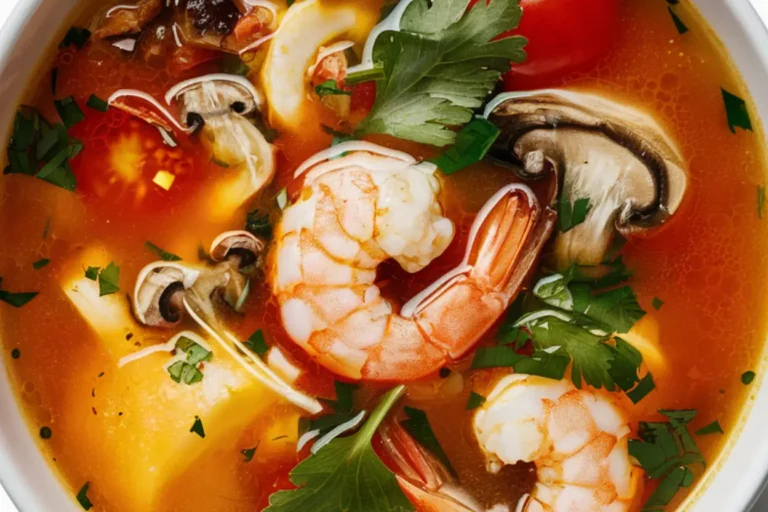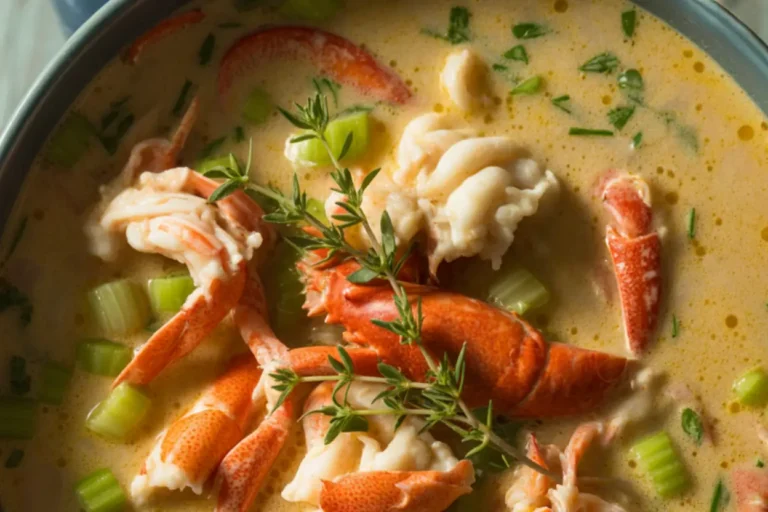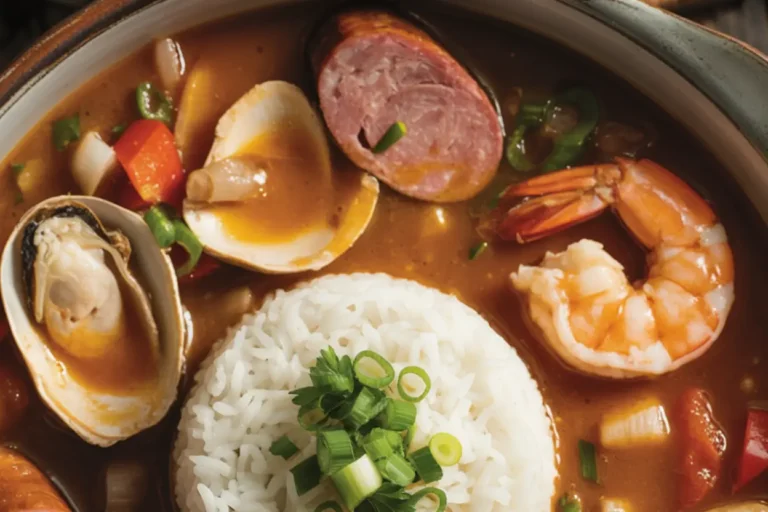Salmon Soup: How to Make It Rich Without Heavy Cream
Table of Contents
There’s something magical about a bowl of salmon soup on a chilly evening. The rich broth, tender chunks of salmon, and aromatic vegetables come together to create a comforting meal that feels indulgent yet nourishing. But here’s the thing – many traditional salmon soup recipes rely heavily on cream to achieve that luxurious texture. What if I told you that you could create an incredibly rich and satisfying salmon soup without a drop of heavy cream? That’s exactly what I’m sharing today.
Thank you for reading this post, don't forget to subscribe!How to Make Salmon Soup
Quick Overview
This salmon soup is the perfect balance of hearty and healthful – a silky, flavorful broth filled with chunks of tender salmon, colorful vegetables, and fresh herbs. What makes this recipe special is how it achieves a wonderfully creamy texture without relying on heavy cream, making it lighter yet still incredibly satisfying. The secret lies in a technique that creates a velvety mouthfeel while letting the natural flavors of the salmon shine. From starting the soup to serving it at the table, you’ll need about 45 minutes, with only 15 minutes of active preparation time. Even on busy weeknights, this salmon soup delivers restaurant-quality results with minimal effort.
The Ingredients I Use to Bring My Salmon Soup to Life
For the Soup Base:
- 1 pound fresh salmon fillets, skin removed and cut into 1-inch cubes
- 2 tablespoons olive oil
- 1 large yellow onion, finely diced (about 1 cup)
- 2 medium carrots, diced into small cubes (about 3/4 cup)
- 2 celery stalks, finely chopped (about 1/2 cup)
- 3 garlic cloves, minced
- 1 leek, white and light green parts only, thinly sliced
- 1 medium potato, peeled and diced into 1/2-inch cubes (about 1 cup)
- 4 cups fish stock (or vegetable stock)
- 1 cup water
- 2 bay leaves
- 1 teaspoon dried thyme
- 1/4 teaspoon red pepper flakes (optional)
- Salt and freshly ground black pepper to taste
For the Creamy Element (No Cream Needed!):
- 1 cup full-fat coconut milk
- 2 tablespoons cornstarch mixed with 2 tablespoons cold water
- 1 tablespoon miso paste (white or yellow)
For the Finishing Touches:
- 2 tablespoons fresh lemon juice
- 1/4 cup fresh dill, chopped, plus extra for garnish
- 2 tablespoons fresh parsley, chopped
- 2 green onions, thinly sliced
Step-by-Step Instructions
- Prepare the salmon: After removing the skin, check for any remaining bones in your salmon fillets. Cut the salmon into 1-inch cubes, season lightly with salt and pepper, then refrigerate while preparing the rest of the soup.
- Create the aromatic base: Heat the olive oil in a large Dutch oven or heavy-bottomed pot over medium heat. Add the diced onion, carrots, and celery. Cook for 5-6 minutes, stirring occasionally, until the vegetables begin to soften but not brown.
- Add depth of flavor: Stir in the minced garlic and sliced leeks. Cook for another 2 minutes until fragrant and the leeks start to soften.
- Build the soup base: Stir in the diced potatoes, mixing them well with the other vegetables in the pot. Pour in the fish stock and water, then drop in the bay leaves, a sprinkle of dried thyme, and red pepper flakes if you like a bit of heat. Season with a pinch of salt and black pepper to taste.
- Simmer the base: Bring the mixture to a gentle boil, then reduce the heat to maintain a simmer. Cook uncovered for about 15 minutes, or until the potatoes are just tender when pierced with a fork.
- Create the creamy element: In a separate bowl, whisk together the coconut milk and cornstarch mixture until smooth. Dilute the miso paste with a few tablespoons of the hot broth from the soup, then stir until completely dissolved.
- Combine and thicken: Pour the coconut milk mixture into the soup and stir well. Add the diluted miso paste. Let the soup simmer for about 5 minutes, giving it a gentle stir now and then, until it starts to thicken a bit.
- Cook the salmon: Gently add the salmon pieces to the pot. Cook for just 3-4 minutes until the salmon is opaque and flakes easily with a fork. Be careful not to overcook the salmon, as it will continue to cook slightly from the residual heat.
- Finish with brightening elements: Remove the pot from heat. Discard the bay leaves, then stir in the fresh lemon juice, chopped dill, and parsley.
- Taste and adjust: Sample the soup and adjust the seasoning with additional salt, pepper, or lemon juice as needed.
- Serve: Ladle the hot salmon soup into bowls, garnish with sliced green onions and additional fresh dill. Serve immediately for the best flavor and texture.
What to Serve Salmon Soup With
This salmon soup is substantial enough to serve as a main course, but pairing it with complementary sides elevates the meal:
- Crusty whole grain bread or sourdough rolls are perfect for dipping into the rich broth
- A simple green salad with a light lemon vinaigrette provides a fresh contrast
- Roasted asparagus or steamed green beans with a sprinkle of sea salt make excellent vegetable sides
- Quinoa pilaf with herbs adds a nutritious and textural complement
- For a more substantial meal, serve smaller portions of the soup as a starter before baked cod or grilled vegetables.
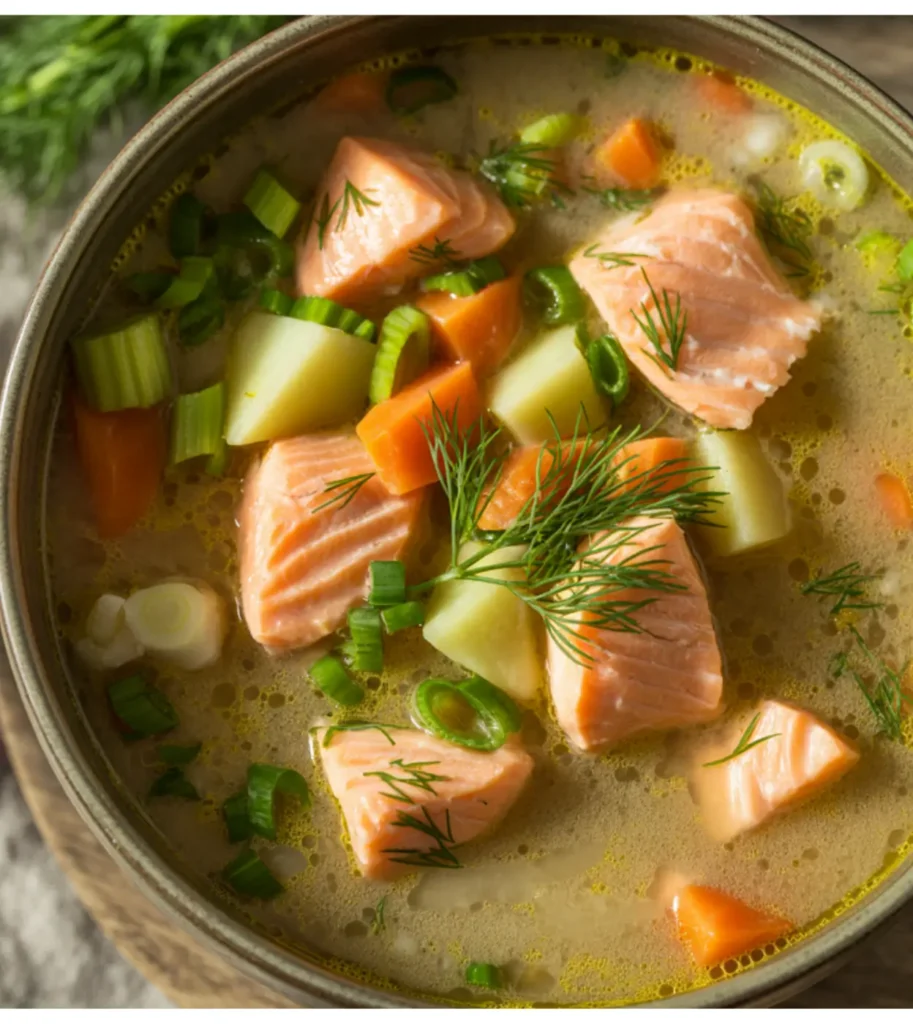
Top Tips for Perfecting Salmon Soup
- Fish selection matters: Use the freshest salmon you can find. While wild-caught salmon offers superior flavor, farm-raised works well too. Aim for center-cut pieces with a vibrant color and minimal “fishy” smell.
- Don’t skip the miso: The miso paste is crucial for developing umami depth that mimics the richness typically provided by cream. If you don’t have miso, substitute 1 tablespoon of fish sauce or 2 teaspoons of soy sauce.
- Temperature control is key: Never boil the soup after adding the salmon or coconut milk. Gentle simmering preserves the delicate texture of the fish and prevents the coconut milk from separating.
- Consider texture: For a more rustic soup, leave all vegetables diced. For a more refined version, you can purée half the vegetable base before adding the salmon for a smoother consistency.
- Make it your own: This recipe is adaptable—add spinach or kale in the last few minutes, swap potatoes for sweet potatoes, or include other seafood like shrimp or white fish alongside the salmon.
- Troubleshooting too thin soup: If your soup isn’t thick enough, make an additional cornstarch slurry with 1 tablespoon cornstarch and 1 tablespoon cold water, then gradually stir into the simmering soup until you reach the desired consistency.
- Fresh herbs make a difference: While dried herbs work in the base, fresh herbs added at the end provide brightness that transforms the soup. If fresh dill isn’t available, substitute with fresh parsley or chives.
Storing and Reheating Tips
Salmon soup is best enjoyed fresh, but leftovers can still be delicious with proper handling:
Refrigeration: Transfer cooled soup to airtight containers within two hours of cooking. Properly stored, salmon soup will keep for 2-3 days in the refrigerator. The flavors often develop and improve overnight, making this an excellent make-ahead meal.
Freezing considerations: While you can freeze this soup, be aware that the texture of the salmon and potatoes will change slightly upon thawing. If planning to freeze, consider slightly undercooking the salmon and potatoes. Freeze in individual portions in freezer-safe containers, leaving about an inch of headspace for expansion. Frozen salmon soup can be stored for up to 2 months.
Reheating properly: Gentle reheating is essential for preserved flavor and texture. Warm refrigerated soup over medium-low heat until just heated through, stirring occasionally but gently to avoid breaking up the salmon pieces. Alternatively, microwave on 70% power in 1-minute intervals, stirring between each until warmed.
Refresh before serving: When reheating, you may find the soup has thickened considerably. Simply add a splash of stock or water to reach your desired consistency. Before serving reheated soup, add a squeeze of fresh lemon juice and a sprinkle of fresh herbs to revitalize the flavors.
With these tips and techniques, you’ll create a salmon soup that’s rich and satisfying without relying on heavy cream. The result is a lighter yet still luxurious soup that lets the natural flavors of salmon take center stage.
Salmon Soup: How to Make It Rich Without Heavy Cream
Cuisine: Fusion asian inspiredDifficulty: Easy to Moderate4
servings20
minutes30
minutes400-450
kcalA comforting and flavorful bowl of Salmon Soup made with tender salmon chunks, aromatic vegetables, creamy coconut milk, and a miso-lemon finish. It’s both nourishing and bright, blending coastal freshness with a hint of Asian-inspired depth.
Ingredients
1 pound fresh salmon fillets, skin removed and cut into 1-inch cubes
2 tablespoons olive oil
1 large yellow onion, finely diced (about 1 cup)
2 medium carrots, diced into small cubes (about 3/4 cup)
2 celery stalks, finely chopped (about 1/2 cup)
3 garlic cloves, minced
1 leek, white and light green parts only, thinly sliced
1 medium potato, peeled and diced into 1/2-inch cubes (about 1 cup)
4 cups fish stock (or vegetable stock)
1 cup water
2 bay leaves
1 teaspoon dried thyme
1/4 teaspoon red pepper flakes (optional)
Salt and freshly ground black pepper to taste
1 cup full-fat coconut milk
2 tablespoons cornstarch mixed with 2 tablespoons cold water
1 tablespoon miso paste (white or yellow)
2 tablespoons fresh lemon juice
1/4 cup fresh dill, chopped, plus extra for garnish
2 tablespoons fresh parsley, chopped
2 green onions, thinly sliced
Directions
- Prepare the Salmon
Remove the skin from the salmon fillets and check for any leftover bones. Cut the fish into 1-inch cubes, season lightly with salt and pepper, and set it aside in the refrigerator while you prepare the rest of the soup. - Build the Aromatic Base
In a large Dutch oven or heavy-bottomed pot, heat the olive oil over medium heat. Sauté the diced onion, carrots, and celery for about 5–6 minutes until softened. Then add the minced garlic and sliced leeks, cooking for another 2 minutes until everything is fragrant and just starting to soften. - Simmer the Soup Base
Add the diced potatoes and mix them in with the sautéed vegetables. Pour in the fish stock and water, then add the bay leaves, dried thyme, red pepper flakes (optional), and a pinch of salt and black pepper. Bring the mixture to a boil, then lower the heat and let it simmer for about 15 minutes, until the potatoes are tender. - Make it Creamy & Flavorful
While the soup simmers, whisk together the coconut milk and cornstarch in a bowl until smooth. In a separate small bowl, dissolve the miso paste using a few spoonfuls of hot broth from the soup. Stir both the coconut milk mixture and the miso into the pot. Let the soup simmer for another 5 minutes until slightly thickened. - Finish & Serve
Carefully add the salmon cubes into the pot and simmer for 3–4 minutes, just until the fish turns opaque and flakes easily. Remove the soup from the heat, discard the bay leaves, and stir in fresh lemon juice, chopped dill, and parsley. Taste and adjust seasoning if needed. Serve hot, garnished with green onions and extra dill.
Notes
- This soup is a vibrant mix of Nordic-style fish chowder and Japanese-inspired flavors. The addition of miso paste and coconut milk gives it a unique umami depth and creamy richness, without relying on dairy. Fresh herbs like dill, parsley, and green onion add brightness to every spoonful, while the salmon remains the star. Feel free to swap fish stock with vegetable stock if you’re aiming for a lighter or pescatarian version. It’s an excellent one-pot meal for chilly evenings or when you crave something wholesome yet exciting.

